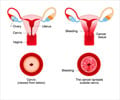HPV self-tests offer a convenient way to detect cervical cancer risk.

Human papillomavirus genotype and cycle threshold value from self-samples and risk of high-grade cervical lesions: A post hoc analysis of a modified stepped-wedge implementation feasibility trial
Go to source) The study is based on British women who were offered a self-test for HPV in a trial because they were overdue for their cervical cancer screening.
‘Want to take control of your #cervical health? #HPV self-tests are a convenient and effective way to screen for #cervicalcancer. #womenshealth’





Expanding Access to Cervical Cancer Screening
"It reaches women who would not otherwise participate," says Jiayao Lei, assistant professor at the Department of Medical Epidemiology and Biostatistics and Department of Clinical Science, Intervention and Technology, who is the lead author of the study.The study, conducted in primary care centres in England, included 855 women with a positive HPV self-test, i.e. indicative of HPV infections, and had a subsequent clinician-sample. It was found that 71 of these women (8.3%) had the severe cervical precancer or cancer.
The researchers looked at the details of the HPV test results on self-sample and used a new method to assess the risk of severe cellular changes. The risk stratification is based on the variant of the HPV virus and the amount of virus (measured as the cycle threshold, Ct value) present in the self-test. Using this, they divided the women into three risk groups: high, medium and low risk. Women with HPV type 16 and a low Ct value (<30) had the highest risk of severe cervical precancer or cancer.
"About 40% of women in our high-risk group had been diagnosed with the severe cervical precancer or cancer that requires treatment. Therefore, our recommendation for the future is that this group be referred directly for further investigation with colposcopy," says Jiayao Lei.
More than half of those who tested positive were in the low-risk group, with a 4% probability of being diagnosed with severe cervical precancer or cancer within 12 months.
Advertisement
One of the major advantages of the new method is that the risk assessment can be done directly after the HPV self-test, without the need for further laboratory analyses.
We will perform a large-scale population studies based on self-tests in Sweden based on a different assay to test the feasibilities of including such risk stratification into the routine screening programs, supported by Swedish Cancer Society. We also want to investigate the predictive values of the current test results in combination with other markers for HPV-positive women.
Reference:
- Human papillomavirus genotype and cycle threshold value from self-samples and risk of high-grade cervical lesions: A post hoc analysis of a modified stepped-wedge implementation feasibility trial - (https://journals.plos.org/plosmedicine/article?id=10.1371/journal.pmed.1004494)















